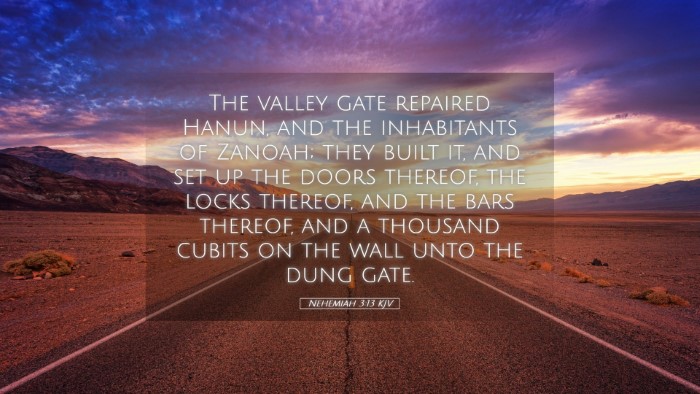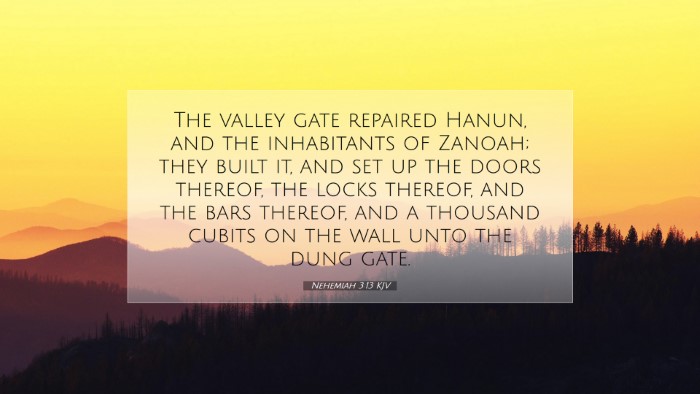Commentary on Nehemiah 3:13
Bible Verse: Nehemiah 3:13 - "The valley gate repaired Hanun and the inhabitants of Zanoah; they built it and set up the doors thereof, the locks thereof, and the bars thereof."
Overview and Context
This verse is part of a larger narrative detailing the rebuilding of Jerusalem's walls after the return of the exiles from Babylon. Nehemiah, serving as governor, mobilized the people to engage in this crucial task. In chapter 3, specific gates and sections of the wall are enumerated, along with the individuals and groups who undertook the repair work.
Significance of the Valley Gate
The Valley Gate was located on the southwestern part of Jerusalem, leading down towards the valley of Hinnom. Its repair signifies the importance of maintaining access to this area, which played a role in the civil and military defense of the city.
- Symbolism of Gates: Gates in the Bible often symbolize access and security. The fixing of the Valley Gate not only restored physical protection but also represented a revival of divine order.
- Community Involvement: The verse highlights the collaborative effort of the inhabitants, particularly mentioning Hanun and the men of Zanoah. This showcases the unity and collective purpose among the people of God in rebuilding their city.
Insights from Public Domain Commentaries
Matthew Henry: Henry emphasizes the communal aspect implied in this verse, noting that the repair work done by Hanun and the inhabitants of Zanoah reflects a shared responsibility among God's people. He points out that even the least of communities can greatly contribute to God's work when they act collectively.
Albert Barnes: Barnes draws attention to the historical and symbolical aspects of the gates. He notes that the Valley Gate could be seen as signifying humility, as it lies lower than the city itself. The act of repairing could therefore represent the people humbling themselves before God to restore their spiritual and physical state.
Adam Clarke: Clarke offers a detailed analysis of the geographical location of the Valley Gate. He argues that this gate was a strategic point for entering Jerusalem and illustrates the dangers of neglecting such important structures. Clarke interprets the text as a call to vigilance and careful management of community resources for the glory of God.
Theological Reflections
This verse and the work done by Hanun and the inhabitants of Zanoah present profound theological themes:
- Restoration: The act of repairing the gates of Jerusalem can be seen as a metaphor for spiritual restoration. The rebuilding reflects God's desire for His people to return to Him and re-establish their covenant.
- Unity in Diversity: Different people from various backgrounds come together to achieve a common purpose, a beautiful illustration of the body of Christ in action, where each member is important and plays a role in God's kingdom work.
Practical Applications for Today
The narrative around Nehemiah 3:13 extends beyond historical significance to offer practical lessons for contemporary believers:
- Engagement and Participation: Just as Hanun and the inhabitants of Zanoah engaged in the rebuilding process, modern Christians are called to participate actively in the work of rebuilding the spiritual and moral fabric of their communities.
- Humility Before God: The act of repairing a gate symbolizes coming humbly before God. Individuals and congregations should reflect on areas that need restoration, both personally and corporately.
- Collective Responsibility: This verse highlights communal effort; thus, churches and groups are encouraged to foster an environment where everyone's contributions are valued as they work towards common goals.
Conclusion
Nehemiah 3:13 serves as a reminder of the importance of unity and diligence in fulfilling God’s plans. Through the insights of various commentaries, we understand the deeper implications of this passage—calling for restoration, humility, and communal effort. As we heed these lessons, may we find ways to contribute to the rebuilding of not only our communities but our spiritual lives as well.


